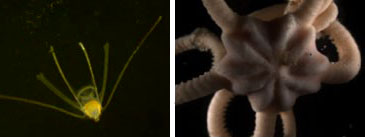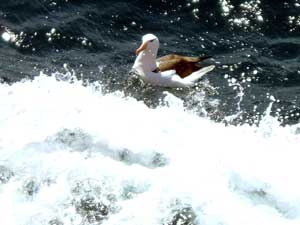| • Home |
| • Questions |
| • Participants |
| • Background Information |
We continue to head due east, taking ocean samples on a rotating schedule, about every 4 hours. So far, I’ve been on the sea bottom trawl shifts for the most part, and

| 1 | 2 | 3 | 4 | 5 | 6 | |
| 7 | 8 | 9 | 10 | 11 | 12 | 13 |
| 14 | 15 | 16 | 17 | 18 | 19 | 20 |
| 21 | 22 | 23 | 24 | 25 | 26 | 27 |
| 28 | 29 | 30 |
| 1 | 2 | 3 | 4 | |||
| 5 | 6 | 7 | 8 | 9 | 10 | 11 |
| 12 | 13 | 14 | 15 | 16 | 17 | 18 |
| 19 | 20 | 21 | 22 | 23 | 24 | 25 |
| 26 | 27 | 28 | 29 | 30 | 31 |
get to sort with my hands instead of with tweezers and pipettes, which is sometimes good, sometimes bad. That slimy seastar image will be with me for a while.
Along the way, I’ll tell about the people on the cruise. I find them all very nice, and as the days go on, I am learning their names and their different and interesting backgrounds (how did we all wind up out here together?). Nerida (pronounced “Nayr-da”) is from Australia, and she enjoys studying nudibranchs, which I must say, are quite fetching and colorful snails without shells. Nerida’s just as comfortable as anyone’s little brother would be, picking up and scraping off slimy things, slicing up, photographing and packaging them for a later look-see. Jonathan is the youngest student scientific crew member, and he likes fish, but knows his smaller sea critters quite well for a “newcomer” to the field. Guilliaume is a Chilean from Punta Arenas, and he is a ship’s crew member, cleaning and keeping things ‘shipshape’. He has two sons with almost the same age span as my children, so we had something in common (besides ship life) to talk about. Raul is a professor of physical oceanography at the Universidad Nacional de Mar del Plata (National University of the Silver Sea - isn’t that appealing??). He teaches undergraduates in marine biology, and his title here is “Argentine Observer”, but he is hands-on involved in all of the labs.
On Thanksgiving I assisted in the photo lab while Larry Madin, the jelly team leader, took pictures of salps in his nifty photography tank setup. It is a small, narrow Plexiglas aquarium (14x16x3?) with a black background and side lighting. I had to resist watching the surface of the water in the tank as it shifted first left, then right with the roll of the ship. The jellies didn’t seem to mind that, and with a little stirring above the subject using a long pipette, it would spin and dance the most delicate serpentine ballet. It is beautiful to see, and would probably be well put to music. The dive group did go out late today, and among other samples, brought back the most remarkable 7-inch ctenophore (“tee-nuh-fore”, a blimp-shaped jelly)!! It was pinkish in color, and showed vibrant colors flashing along its “seams” all the time we watched and photographed it. Today’s benthic trawl brought up fewer slimy stars, and many more brittle stars with long curly legs. These are relatives of the “basket star” from a previous photo posted, but their legs don’t get the little branches like the basket star. See the photo of the larva of this same type of critter [Image 1]. This came up in an earlier (today) plankton net, and had its picture taken under microscope. Most of the adults are only the size of the palm of your hand, but are quite strong when they coil their legs around netting or a nearby piece of seaweed or each other!
We sorted the sample out on deck in bright sunshine with the pleasant company of probably 200 seabirds. Most of these were petrels, but now the black-browed albatross are making a large show in the population. I don't know what they expect from us, our “throwback” is not what they'd like for a meal, but they’re there nonetheless… perhaps just for our entertainment? [See the resting Albatross in Image 2]
We are still heading east right now, but will turn back just under the Falkland Islands toward the west again to Staten Island, and then go southeast toward Elephant Island, passing the tip of South America to our right (do you have a map? We’re at the bottom of the continent!). We will be in more open waters on that latter leg (the Drake Passage).
The wind and waves will likely go into high gear and give us a good run for our money, with winds probably gusting to 50mph,

and the decks constantly awash from huge waves coming over the sides of the ship. It is an awesome sight, I’m told!! We’ve been advised to do our laundry before the crossing, because the washing machines would slosh their water out, so that’s where I’m headed!
Dinner Menu (shipboard, 11/26): |
|
TBD |